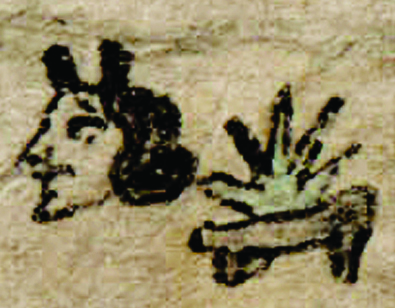Magdalena (BMapH46)
This black-line drawing of the simplex glyph for the personal name, Magdalena, taken from the Christian Bible and pertaining to a woman, includes two elements. One appears to be an agave plant (metl) with five branches spiking upward. Alternatively, this may be a hand (maitl) with its five fingers spread open. Whichever noun this is meant to be, it must be a phonetic indicator that the name starts with Ma-. Below this appears to be a grinding stone (metlatl), which is also possibly phonetic but also has a semantic value in that it has a strong association with women, given that women spent many hours grinding maize with which to feed their families.
Stephanie Wood
Further research or consultation is required to be clear about the interpretation of the elements. But this is a baptismal name that comes from the colonizers’ religion. Nahua glyphs exist for a number of Spanish given names and surnames, as shown below.
Stephanie Wood
This glyph is not glossed; the transliteration of the glyph comes from Gordon Whittaker’s contribution to the study by Mary E. Miller and Barbara E. Mundy (2012).
c. 1565
Jeff Haskett-Wood
magueyes, manos, metates, nombres de mujeres

ma(itl), hand, https://nahuatl.wired-humanities.org/content/maitl
me(tl), agave plant, https://nahuatl.wired-humanities.org/content/metl
metla(tl), grinding stone, https://nahuatl.wired-humanities.org/content/metlatl
Magdalena
Stephanie Wood
Beinecke Map/Codex Reese, section 8, no. 46 in the Whittaker study (published in the Miller/Mundy book, 2012), and see the original at: https://brbl-dl.library.yale.edu/vufind/Record/3600017
The Bodleian Libraries, University of Oxford, hold the original manuscript, the MS. Arch. Selden. A. 1. This image is published here under the UK Creative Commons, “Attribution-NonCommercial-ShareAlike 3.0 License” (CC-BY-NC-SA 3.0).




